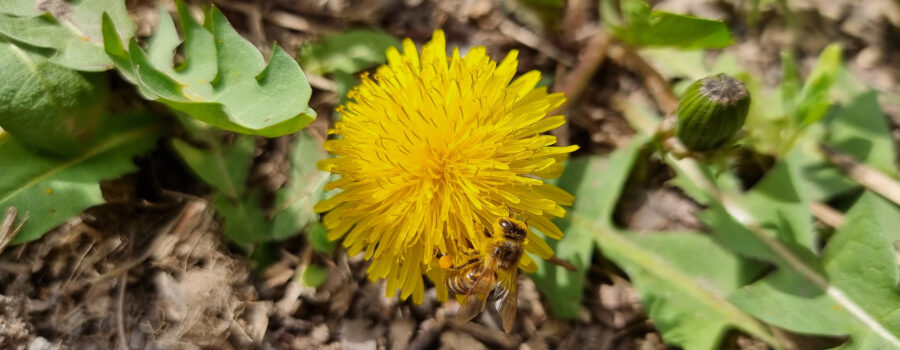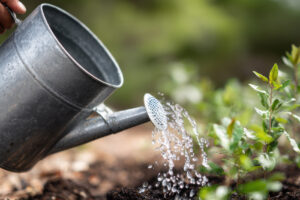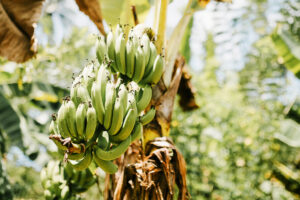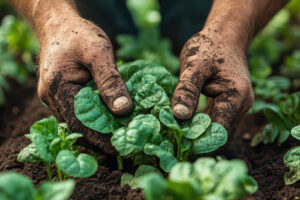When I first started my permaculture food forest, I regularly pulled weeds, waging war against anything that didn’t belong to my tidy plan. Dandelions, chamberbitter, spurge, dollarweed all had to go. I considered them threats to my carefully cultivated food-producing paradise. But as the seasons passed and the forest grew into a more self-sustaining system, something shifted. I started to see those so-called weeds in a completely new light.
Developing a food forest has transformed my relationship with weeds. Weeds can serve a valuable purpose in an ecosystem. Whether you’re gardening, as I am, in north central Florida or halfway across the world, understanding weeds through the lens of permaculture can make us more intuitive and resilient growers.
What Is a “Weed” Anyway?
By definition, a weed is a wild plant growing where it is not wanted and in competition with cultivated plants. It has little to do with the plant’s species, nutritional value, or ecological role. Dandelions might be despised in a suburban lawn, but they’re prized in herbal medicine and permaculture for their deep roots and edible leaves. So weeds are a matter of perspective. And in a food forest — a polyculture system designed to mimic a natural ecosystem — that perspective can evolve quickly.
Like many gardeners following conventional advice, I believed a tidy garden was important. I spent too much time trying to keep things under control, but nature will not be controlled. It will find a way to cover bare soil and fill every niche.
Observing Weeds in My Florida Yard
Bidens alba shows up in my yard endlessly. There isn’t much I can do to stop it. Before I studied permaculture and began my food forest, I did my best to fight it. The more I pulled it, the faster it seemed to show up. Worse, I was losing soil fertility and disrupting beneficial insect and fungal networks. That’s when I realized I wasn’t gardening with nature. I was gardening against it.
Before the back of our neighborhood was developed, I could find elderberry, passion vine, and muscadine grapes growing wild in empty lots. Beautyberry, a Florida native, also grows wild along the shady edges of our yard.
Read on to learn how I view them now…
Weeds in the Food Forest
As my food forest matured, I started to let go. I stopped pulling everything that showed up on its own and began observing it all instead. Weeds can tell you about the condition of your soil. For example:
- Plantain and dandelion often indicate compacted soil.
- Nutsedge can signal poor drainage or overly acidic conditions.
- Spurge shows up where the soil is dry and nutrient-depleted.
These plants are nature’s way of healing damaged or imbalanced soil. Their presence offers clues we can use to make improvements.
Soil-Building and Nitrogen Indicators
As my food forest matured, I started to let go. I stopped pulling everything that showed up on its own and started to identify and research these plants. While the two listed below are not nitrogen fixers, they are dynamic accumulators. Chopping and dropping them releases accumulated nutrients into the topsoil, making them available to other plants as they decay. The root systems stimulate microbial activity, which can also increase nutrient availability.
Plantain (Plantago major or Plantago lanceolata)
- Benefits: Anti-inflammatory, useful for insect bites, edible leaves
- Uses: Poultices, teas, tender leaves in salads
- Role in Permaculture: Bioindicator of compacted soils; roots help break it up

Spanish Needle (Bidens alba)
- Benefits: Excellent nectar plant for pollinators, young greens are edible
- Uses: Medicinal for wounds
- Role in Permaculture: Pollinator attraction and nutrient accumulator
Spanish Needle, plantain, nutsedge (saline), and spurge (compacted soil, nematode infestation) are indicators
Weeds as a lawn alternative??
How to use Frogfruit and other ground covers…
From Control to Collaboration
The most meaningful shift came when I stopped trying to control my garden and started to collaborate with it. When we embrace organic gardening and refuse to use toxic fertilizers and pesticides, interesting things happen.
Even if you aren’t able to identify any useful weeds right away, pay attention to what appears in the yard naturally and use those plants as a low-maintenance ground cover. Or turn them into fertilizer. Make weed tea. Just fill a large bucket with water, add weeds, cover (to keep mosquitoes away), and let it steep until it stinks. By then, the seeds should no longer be viable.

Medicinal “Weeds”
Sometimes when we explore the world of “weeds,” we discover healing gifts. My integrative doctor suggested taking Chanca Piedra (Spanish for “stone breaker”) for gallstones. I did this on and off for years, successfully treating occasional inflammation and pain. Once I started growing more unusual medicinal herbs in my garden, I began to wonder if I could acquire and grow Chanca Piedra (Phyllanthus niruri). As I began to research this herb, I realized that the photos looked familiar.
Chamberbitter (Phyllanthus urinaria) invades my yard prolifically in the summer. Both are members of the Phyllanthus genus, used in herbal remedies for urinary and gallbladder issues. While troublesome to many gardeners, it offers a host of health benefits and has been used by indigenous people and in Traditional Chinese Medicine for generations.
Note: This information is intended for educational purposes only and should not be considered as a recommendation or an endorsement of any particular medical or health treatment. Both Chanca piedra and Chamberbitter should be used with caution and under the guidance of a healthcare professional, especially if you have pre-existing conditions or are taking medications.
Strategic Chop-and-Drop
I manage more aggressive species by cutting them back before they go to seed. I use the clippings as mulch around young trees and shrubs. This builds soil and reduces the need for external compost.
Weed-Guilding
Weeds can be an important part of plant guilds. For example, plantain will help loosen compacted soil around fruit trees, while wild violets attract pollinators to my understory layer. If I want to reduce weed pressure, I outcompete them with dense plantings of ground covers like sweet potato, sissoo spinach, perennial peanut, or clover.
What About Truly Invasive Plants?
The key is discerning which plants are helpers and which are disruptors. Observation is everything. Apply a thick layer of mulch (straw, wood chips, leaves, cardboard) to suppress weed growth by blocking sunlight and moisture.
Working With Weeds
In nature, every plant has a purpose. Weeds fill voids and heal damaged areas. What initially seems like a nuisance may be part of a bigger cycle of regeneration. In a food forest, where every element should serve multiple functions, weeds can provide healing by feeding and protecting the soil. Try using edible weeds in your meals or brewing them into compost teas to fertilize plants. Encourage competition. Use ground covers, interplanting, and dense mulching to reduce unwanted species.
From Nuisance to Ally
In permaculture, an important principle is to “produce no waste.” The problem is often the solution. Weeds can be considered a resource. Instead of seeing a weedy area as a failure, we can see it as an opportunity to learn from nature.
Food forests are living experiments, and sometimes, weeds are helpful guides. Instead of reaching down to yank out a plant, we should pause. Those weeds we once considered an annoyance can actually be the healers our soil (and even our body) needs.
Copyright © 2025 Fruitful Food Forestry & Lauren Lynch. No portion of the original content on this website may be reproduced, in any language, without express written consent.









Leave a Reply
Your email is safe with us.